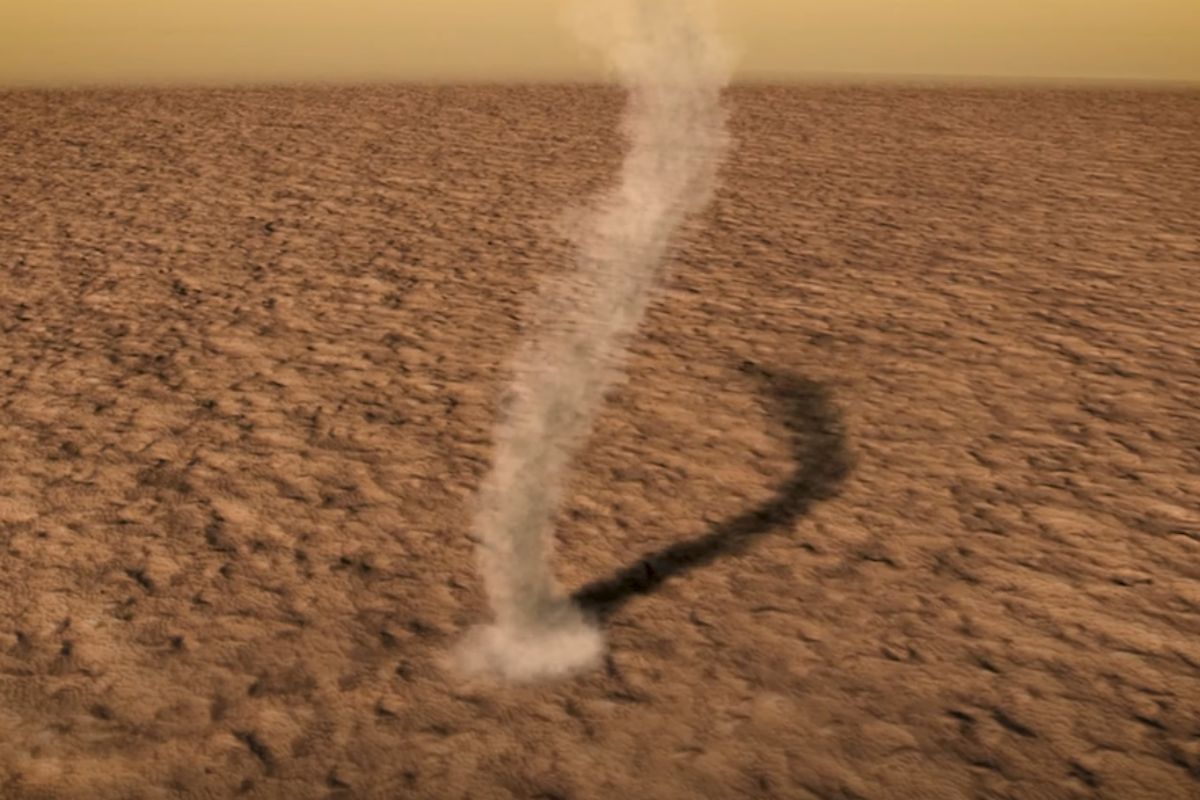NASA recently published some striking images captured by the Perseverance rover. For the first time, a video shows an imposing swirl of Martian dust absorbing another, smaller swirl. This atmospheric spectacle, observed on the relief of the Jezero crater, provides valuable information about the meteorology of the Red Planet.
An atmospheric ballet captured by Perseverance Mars once again reveals its fascinating atmospheric secrets.
On 3 April 2025, NASA’s Jet Propulsion Laboratory (JPL) shared an exceptional video sequence, immortalized by the Perseverance rover on 25 January 2025. While exploring an area known as “Witch Hazel Hill” on the western rim of the Jezero crater, the rover witnessed a spectacular meteorological phenomenon: a Martian dust devil, sometimes compared to an Earth tornado although different in formation and intensity, in the process of “consuming” another.
The scene, filmed from a distance of around one kilometer using one of the rover’s navigation cameras, shows a main vortex, estimated to be 65 meters wide, literally sucking in a much smaller congener, around 5 meters in diameter. As explained by Mark Lemmon, Perseverance mission scientist at the Space Science Institute, these “convective vortices”, nicknamed dust devils, are columns of rotating air and dust that are common on Mars. Their encounter can lead to mutual destruction or, as here, to a fusion in which the more powerful absorbs the weaker. The video also reveals the presence of other, more distant eddies, testifying to the intense atmospheric activity that day.
Far from being a mere visual curiosity, the study of these eddies is crucial for scientists. As Katie Stack Morgan, Perseverance project scientist at JPL, points out, “Dust devils play a significant role in Martian weather patterns”. By observing them, we can estimate the direction and speed of the prevailing winds. What’s more, these phenomena are responsible for transporting around half of the dust present in Mars’ atmosphere, thereby influencing the planet’s overall climate and visibility. This video capture is part of an imaging experiment carried out specifically by the Perseverance scientific team to gain a better understanding of the dynamic forces at work in the thin Martian atmosphere. This is not the first time that Perseverance has observed these structures: in September 2021, it had already filmed a ‘dance’ of several eddies and even recorded, using its SuperCam microphone, the first sounds of a dust devil passing nearby.
The science behind the wormhole How do these ephemeral dancers come into being? The process is initiated by the sun heating the Martian soil. The air in contact with this warm surface rises, because it is less dense than the colder air at higher altitudes. To fill the void left by the rising air, cooler air converges towards the base of the rising column. This convergent movement, combined with any surface winds, initiates a rotation. As the air rushes in and rises, the column tightens and, by conservation of angular momentum (like a skater bringing her arms towards her body to turn faster), its speed of rotation accelerates. By sucking in the air, the vortex also lifts the fine Martian dust, making it visible: the dust devil is born.
A long history of observations documenting these phenomena is nothing new. As early as the 1970s, NASA’s Viking orbiters took the first photographs of these columns from space, revealing their shadows cast on the ground. Two decades later, the Pathfinder mission was the first to image one from the surface and even to detect the passage of a vortex directly above its lander. The twin rovers Spirit and Opportunity, followed by Curiosity (currently exploring Mount Sharp in Gale Crater), have all added their share of observations to this collection.
Science This strange red lake in Tanzania turns animals to ‘stone’.
However, photographing or filming a dust devil requires a certain amount of luck. Their appearance remains unpredictable. That’s why Perseverance carries out regular, panoramic surveillance. When the scientists detect an increased frequency at certain times or a preferred direction of approach, they can concentrate their observations to increase the chances of capture.
For those who are worried about the fate of the little swirly that was “swallowed”, Mark Lemmon offers a form of consolation tinged with scientific realism: “The big aggressor very probably met its own end a few minutes later”. Indeed, the life span of these dust devils on Mars rarely exceeds around ten minutes.
While this video offers a spectacular insight into Martian dynamics, it is also part of the much broader objectives of the Perseverance mission. Its primary aim is astrobiology, in particular the search for signs of ancient microbial life and the collection of rock and soil samples (regolith) that will one day be brought back to Earth by the Mars Sample Return program (in collaboration with ESA). The rover is also studying the past geology and climate of Mars, paving the way for future human exploration of the Red Planet, a key step in NASA’s “Moon to Mars” vision.
This new observation by Perseverance reminds us of the complexity and beauty of natural phenomena at work on other worlds, while underlining the importance of our robotic explorers in deciphering the mysteries of our planetary neighbor.


